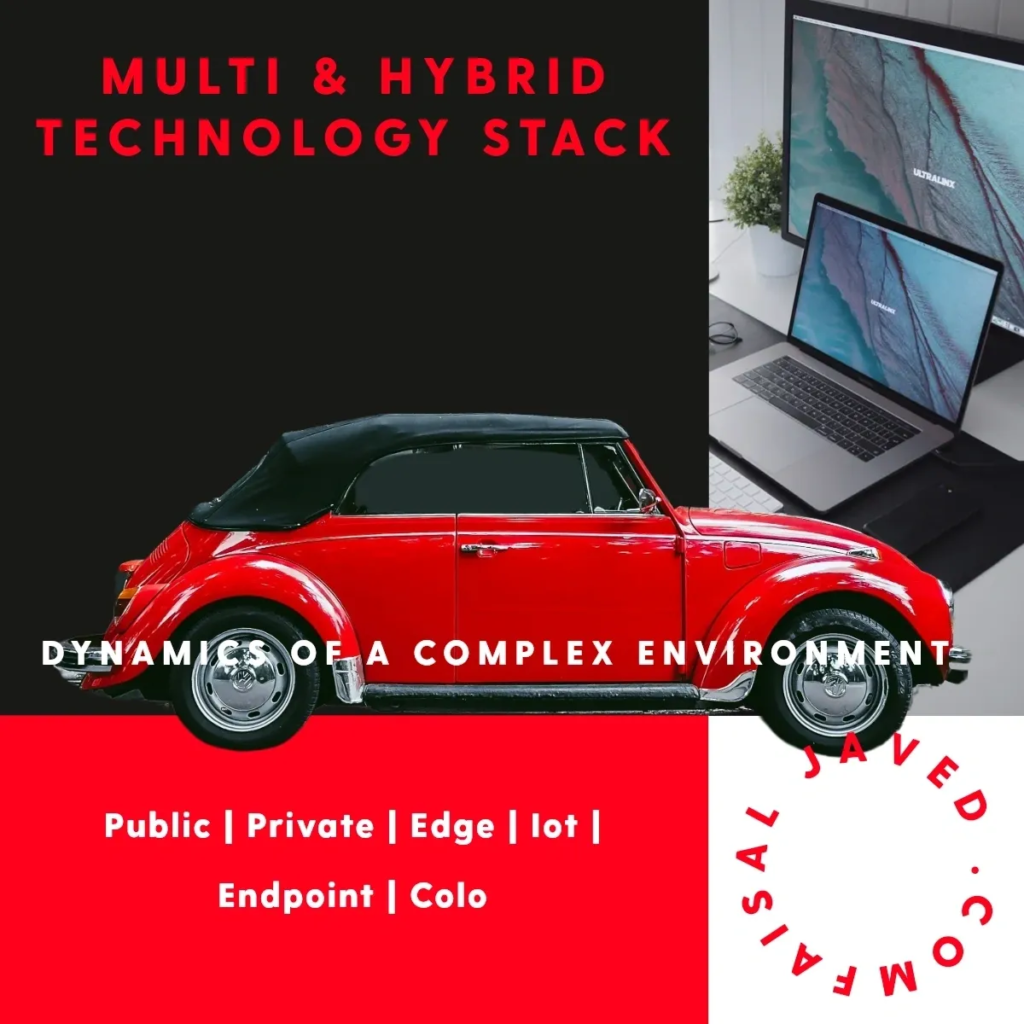
Topic is so interesting, I had circle back on this. Hybrid Infrastructure are becoming a day-today reality for us. Managing them is a very different story. I can understand the reasons for their popularity i.e.
🙂 Well rounded version of why they are popular; “As organizations seek to leverage the benefits of both public and private cloud environments, reduce cost of ownership, future readiness and keep pace with rapid changing technology needs”
Realistic version; They are easy to understand and it dumps all the complex-y no-one-is-interested stuff in a box and let someone manage that. While business can use it to focus on what matters to business. Even if costs more and has known drawbacks (technical and non-technical).
However, for us technical folk. Managing hybrid technologies can pose some challenges, such as ensuring security, compatibility, performance, and cost-efficiency. In this blog post, we will discuss some of the best practices for managing hybrid technologies and recommend some key systems that can help you achieve your goals.
One of the main challenges of hybrid technologies is ensuring security across different platforms and networks. To address this, you need to implement a unified security policy that covers both your public and private cloud resources. This means applying consistent encryption, authentication, authorization, and auditing standards across all your data and applications. You also need to monitor and protect your network traffic and endpoints from potential threats and vulnerabilities. Some of the key systems that can help you with security are:
– Cloud Access Security Broker (CASB): A CASB is a software tool that acts as a gatekeeper between your cloud services and your users. It can enforce your security policy, detect and prevent data breaches, and provide visibility and control over your cloud usage.
– Identity and Access Management (IAM): IAM is a system that manages the identities and access rights of your users and devices. It can verify the identity of your users, grant or deny access to your resources, and manage roles and permissions.
– Firewall: A firewall is a network device that filters and blocks unwanted or malicious traffic from entering or leaving your network. It can protect your network perimeter, segment your network zones, and prevent unauthorized access to your data and applications.
Another challenge of hybrid technologies is ensuring compatibility and interoperability between different platforms and services. To address this, you need to adopt common standards and protocols that can facilitate communication and integration across your hybrid environment. You also need to use tools that can automate and orchestrate your workflows and processes across different cloud resources. Some of the key systems that can help you with compatibility are:
– Application Programming Interface (API): An API is a set of rules and specifications that define how different software components can interact with each other. It can enable data exchange, functionality sharing, and service integration across different platforms and services.
– Container: A container is a software package that bundles an application and its dependencies into a portable and isolated unit. It can run on any platform that supports the container technology, such as Docker or Kubernetes. It can simplify deployment, scaling, and management of your applications across different cloud environments.
– Cloud Management Platform (CMP): A CMP is a software tool that provides a single interface for managing multiple cloud resources. It can automate provisioning, configuration, monitoring, optimization, and governance of your hybrid cloud infrastructure.
A third challenge of hybrid technologies is ensuring performance and reliability across different platforms and networks. To address this, you need to optimize your network connectivity and bandwidth, balance your workload distribution and resource allocation, and implement backup and disaster recovery strategies. Some of the key systems that can help you with performance are:
– Software-Defined Networking (SDN): SDN is a network architecture that decouples the control plane from the data plane. It can enable dynamic routing, load balancing, quality of service, security, and policy enforcement across your network.
– Cloud Load Balancer (CLB): A CLB is a network device that distributes incoming traffic across multiple servers or instances. It can improve availability, scalability, and performance of your applications by reducing latency, congestion, and downtime.
– Cloud Backup and Recovery (CBR): A CBR is a system that copies your data from one location to another for backup or recovery purposes. It can protect your data from loss or corruption due to hardware failure, human error, natural disaster, or cyberattack.
A final challenge of hybrid technologies is ensuring cost-efficiency across different platforms and services. To address this, you need to monitor and analyze your cloud usage and spending, optimize your resource utilization and allocation, and implement cost-saving measures such as scaling up or down according to demand. Some of the key systems that can help you with cost-efficiency are:
– Cloud Cost Management (CCM): A CCM is a software tool that tracks and reports your cloud usage and spending. It can help you identify trends, patterns, anomalies, and opportunities for cost optimization.
– Cloud Resource Optimization (CRO): A CRO is a system that analyzes your resource utilization and allocation across different cloud resources. It can help you optimize performance, availability, security, compliance, and cost of your hybrid cloud infrastructure.
– Cloud Autoscaling (CAS): A CAS is a system that automatically adjusts the number or size of your servers or instances according to the changes in demand or workload. It can help you reduce waste, improve efficiency, and save money by scaling up or down as needed.
Managing hybrid technologies requires a holistic approach that covers security, compatibility, performance, and cost-efficiency aspects. By following the best practices discussed in this blog post and using the recommended key systems, you can successfully manage your hybrid technologies and achieve your business objectives.
I’m really interested to build the knowledge base on this and your feedback…
Expanding your understanding of IT infrastructure is crucial for navigating the complexities of today’s technology landscape. Speaking of **IT Infrastructure**, you might be interested in exploring the concept of Cloud Computing and how it transforms business operations. The role of APIs (Application Programming Interfaces) in facilitating seamless data exchange and integration across diverse platforms is another key area of interest. Additionally, understanding the function of Containerization and how technologies like Docker and Kubernetes simplify application deployment can be quite enlightening. Finally, the concept of Auto Scaling in managing resource allocation efficiently within hybrid environments is a noteworthy addition to your knowledge arsenal. Delving into these topics will enhance your grasp on managing multi-cloud and hybrid infrastructures effectively.

